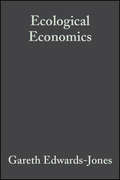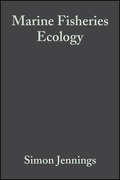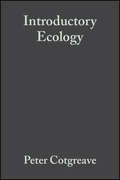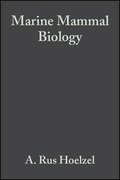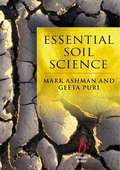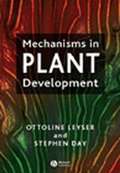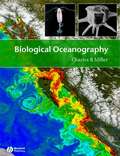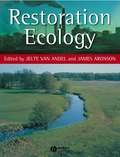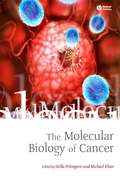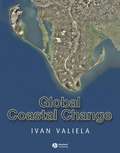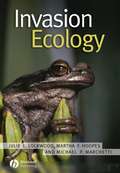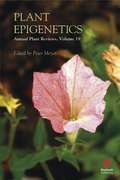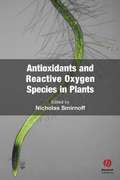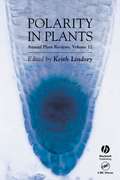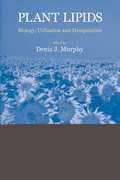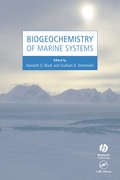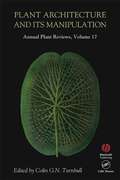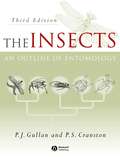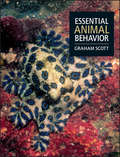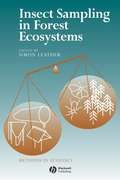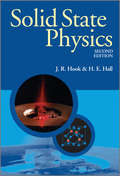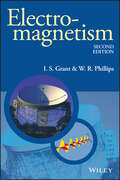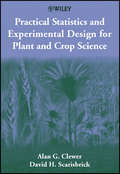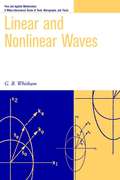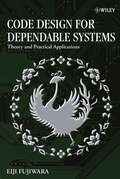- Table View
- List View
Ecological Economics: An Introduction
by Gareth Edwards-Jones Ben Davies Salman S. HussainEcological economics is an exciting interdisciplinary field of study that combines insights from the natural sciences, economics, philosophy and other fields to develop innovative approaches to environmental problems. It draws on a wide range of analytical perspectives, some radical others more conventional, to build a more complete understanding of human-ecosystem interactions. Current research in the field includes work on nature conservation, land use planning, pollution control, natural resource management, and environmental impact assessment/evaluation. Ecological Economics provides a comprehensive introduction to the core themes, presented in a clearly structured style, with chapters tailored specifically to readers without any economic or philosophical training. There is an emphasis throughout on the complementary roles of economics, ethics and ecology in environmental decision-making processes. The book reviews the evolution of important ideas in the field, explores the fundamental philosophies underlying different approaches to environmental problems, explains in detail the specific tools and techniques used in these approaches, and gives numerous examples of how they can be applied. Special importance is attached to understanding both the advantages and limitations of different analyses, in order to provide a balanced and coherent view of how these different approaches interrelate and how their roles vary in different contexts. Written by three authors specializing in ecology, economics and philosophy, this textbook provides an excellent introduction to the field of ecological economics for students in the natural sciences and other environmental disciplines. It will also be of interest to a wide range of professionals and researchers involved in environmental management and policy, and thers including economists seeking to broaden their knowledge of new methodologies and approaches. Further reading suggestions and extensive references are provided for those interested in pursuing particular themes beyond the introductory level. The first introductory ecological economics text written specifically for natural scientists. Assumes no prior knowledge of economics or philosophy. Emphasises the complementary roles of ecology, economics and ethics in environmental decision-making processes. An emphasis on clarity and accessibility throughout.
Marine Fisheries Ecology
by Simon Jennings Michel Kaiser John D. ReynoldsThis topical and exciting textbook describes fisheries exploitation, biology, conservation and management, and reflects many recent and important changes in fisheries science. These include growing concerns about the environmental impacts of fisheries, the role of ecological interactions in determining population dynamics, and the incorporation of uncertainty and precautionary principles into management advice. The book draws upon examples from tropical, temperate and polar environments, and provides readers with a broad understanding of the biological, economic and social aspects of fisheries ecology and the interplay between them. As well as covering 'classical' fisheries science, the book focuses on contemporary issues such as industrial fishing, poverty and conflict in fishing communities, marine reserves, the effects of fishing on coral reefs and by-catches of mammals, seabirds and reptiles. The book is primarily written for students of fisheries science and marine ecology, but should also appeal to practicing fisheries scientists and those interested in conservation and the impacts of humans on the marine environment. particularly useful are the modelling chapters which explain the difficult maths involved in a user-friendly manner describes fisheries exploitation, conservation and management in tropical, temperate and polar environments broad coverage of 'clasical' fisheries science emphasis on new approaches to fisheries science and the ecosystem effects of fishing examples based on the latest research and drawn from authors' international experience comprehensively referenced throughout extensively illustrated with photographs and line drawings
Introductory Ecology
by Peter Cotgreave Irwin ForsethIn this age of increasing human domination of the Earth's biological and physical resources, a basic understanding of ecology is more important than ever. Students need a textbook that introduces them to the basic principles of ecological science, one that is relevant to today's world, and one that does not overwhelm them with detail and jargon. Peter Cotgreave and Irwin Forseth have designed this book to meet the needs of these students, by providing a basic synthesis of how individual organisms interact with their physical environment, and with each other, to generate the complex ecosystems we see around us. The unifying theme of the book is biodiversity-its patterns, causes, and the growing worldwide threats to it. Basic ecological principles are illustrated using clearly described examples from the current ecological literature. This approach makes the book valuable to all students studying ecology. Examples have been chosen carefully to represent as wide a range of ecosystems (terrestrial and aquatic, northern and southern hemisphere) and life forms (animal, plant and microbe) as possible. Particular attention is paid to consequences of global change on organisms, populations, ecological communities and ecosystems. The end result is a text that presents a readable and persuasive picture of how the Earth's natural systems function, and how that functioning may change over the coming century. Features include: · strong coverage of applied and evolutionary ecology · applications of ecology to the real world · a question-orientated approach · the only comprehensive treatment of ecology written for the introductory student · an emphasis on definitions of key words and phrases · an integration of experimental, observational and theoretical material · examples drawn from all over the world and a wide variety of organisms · a logical structure, building from the response of individual organisms to physical factors, through population growth and population interactions, to community structure and ecosystem function · suggested further reading lists for each chapter · boxes to explain key concepts in more depth · dedicated textsite featuring additional information and teaching aids www.blackwellpublishing.com/cotgreave Peter Cotgreave is an animal ecologist who has worked for the University of Oxford and the Zoological Society of London. His research interests centre on abundance and rarity within animal communities. Irwin Forseth is a plant physiological ecologist who has taught introductory ecology and plant ecology at the University of Maryland since 1982. His research focuses on plant responses to the environment. The authors have studied organisms as diverse as green plants, insects and mammals in habitats from deserts to tropical rainforests. They have worked in ecological research and education in Africa, Asia, North and South America, Europe and the Caribbean.
Marine Mammal Biology: An Evolutionary Approach
by A. Rus HoelzelThis book provides a general introduction to the biology of marine mammals, and an overview of the adaptations that have permitted mammals to succeed in the marine environment. Each chapter, written by experts in their field, will provide an up-to-date review and present the major discoveries and innovations in the field. Important technical advances such as satellite telemetry and time-depth-recorders will be described in boxes.
Essential Soil Science: A Clear and Concise Introduction to Soil Science
by Mark Ashman Geeta PuriThis textbook is aimed at the majority of students, who need to quickly acquire a concise overview of soil science. Many current soil science textbooks still cater for a traditional student market where students embark on three years study in a narrow discipline. The growth in modular degree schemes has meant that soil science is now often taught as self-standing unit as part of broad based degree program. Students pursuing this type of course are increasingly reluctant to purchase expensive textbooks that are too detailed and often assume a scientific background. For those opting to specialise in soil science there are a variety of good textbooks to choose from. This short informative guide, will be particularly useful for students who do not possess a traditional scientific background, such as those studying geography, environment science, ecology and agriculture. Only textbook to cater for introductory courses in soil science. Provides an affordable concise overview of soil science. Learning exercises and chapter summaries enhance usability. Annotated suggestions for further reading. Based on proven and successful modular course structure. Emphasis on readability and interactive learning. No scientific background assumed.
Mechanisms in Plant Development
by Ottoline Leyser Stephen DayIntended for undergraduate and graduate courses in plant development, this book explains how the cells of a plant acquire and maintain their specific fates. Plant development is a continuous process occurring throughout the life cycle, with similar regulatory mechanisms acting at different stages and in different parts of the plant. Rather than focussing on the life cycle, the book is structured around these underlying mechanisms, using case studies to provide students with a framework to understand the many factors, both environmental and endogenous, that combine to regulate development and generate the enormous diversity of plant forms. New approach to the study of plant development and a refreshing look at this fast-moving area. Authors focus their discussion on the basic mechanisms which underpin plant development, tackling the fundamental question of how a single cell becomes a complex flowering plant from a cellular perspective. An up-to-date, modern text in plant development for advanced level undergraduates and postgraduates in plant science. Thought-provoking treatment of a difficult subject, the text will satisfy the needs of advanced level undergraduates and postgraduates in plant science. Experimental case studies throughout. The artwork from the book is available at www.blackwellpublishing.com/leyser
Biological Oceanography
by Charles B. MillerThis modern textbook of biological oceanography is aimed at students taking oceanography, marine biology and marine sciences courses. It covers recent developments such as the molecular techniques (including sequence data) that have allowed a re-examination of the ocean's microbial ecology and the role of the various trophic groups in biogeochemical cycling, carbon flow and climate control. Major topics covered include phytoplankton bloom, microbial food web, marine biogeography, global climate change and an overview of fisheries oceanography. Difficult concepts are explained in a straightforward manner, making this book accessible to undergraduates, graduates and researchers alike. Features a chapter on important numerical models which have become indispensable in biological oceanography. Further details of key terms and important topics are highlighted in boxes Models, formulas, methodologies, and techniques are described and explained throughout. An Instructor manual CD-ROM for this title is available. Please contact our Higher Education team at HigherEducation@wiley.com for more information.
Restoration Ecology: The New Frontier
by James Aronson Jelte Van AndelAimed at Masters, and PhD students, teachers, researchers and natural resource managers, this book explores the interface between restoration ecology and ecological restoration. Covers both the ecological concepts involved in restoration ecology and their practical applications. Written by an excellent group of ecologists from centres across Europe with a strong reputation for restoration ecology. Only textbook around aimed specifically at advanced undergraduate courses and postgraduate study programmes.
The Molecular Biology of Cancer
by Stella Pelengaris Michael KhanThis comprehensive text provides a detailed overview of the molecular mechanisms underpinning the development of cancer and its treatment. Written by an international panel of researchers, specialists and practitioners in the field, the text discusses all aspects of cancer biology from the causes, development and diagnosis through to the treatment of cancer. Written by an international panel of researchers, specialists and practitioners in the field Covers both traditional areas of study and areas of controversy and emerging importance, highlighting future directions for research Features up-to-date coverage of recent studies and discoveries, as well as a solid grounding in the key concepts in the field Each chapter includes key points, chapter summaries, text boxes, and topical references for added comprehension and review Supported by a dedicated website at www.blackwellpublishing.com/pelengaris An excellent text for upper-level courses in the biology of cancer, for medical students and qualified practitioners preparing for higher exams, and for researchers and teachers in the field
Global Coastal Change
by Ivan ValielaGlobal Coastal Changeprovides a comprehensive overview of the environmental factors changing the marine systems of the world including atmospheric changes, sea level rise, alterations in freshwater and sediment use and transport, toxins, overfishing, alien species, and eutrophication. Includes case studies providing real-world examples, detailed reviews of the evidence of changes and possible solutions. Brings together a wealth of important information about our changing marine environments. An invaluable reference for upper level undergraduates, graduates, and professionals interested in marine environmental science.
Invasion Ecology
by Julie L. Lockwood Martha F. Hoopes Michael P. MarchettiThis book provides a comprehensive introduction to all aspects of biological invasion by non-native species. Highlighting important research findings associated with each stage of invasion, Invasion Ecology provides an overview of the invasion process from transportation patterns and causes of establishment success to ecological impacts, invader management, and post-invasion evolution. Increasing awareness of the problems associated with invasion has led to a rapid growth in research into the dynamics of non-native species and their adverse effects on native biota and human economies. This book provides a synthesis of this fast growing field of research, and is an essential text for undergraduate and graduate students in ecology and conservation management.
Annual Plant Reviews, Plant Epigenetics (Annual Plant Reviews)
by Peter MeyerWith the discovery of RNAi pathways and the histone code, epigenetics has become a popular and fast evolving research topic. Plant science has made a number of elementary contributions to this field, and the common elements of epigenetic systems have linked research groups interested in plant, fungal and animal systems. This volume provides a comprehensive overview epigenetic mechanisms and biological processes in plants, illustrating the wider relevance of this research to work in other plant science areas and on non-plant systems. It discusses recent advances in our knowledge of basic mechanisms and molecular components that control transcriptional and post-transcriptional silencing, an understanding of which is essential for plant researchers who use transgenic lines for stable expression of a recombinant construct or for targeted inactivation of an endogenous gene. These aspects should be of special interest to the agricultural industry. The volume illustrates the relevance of epigenetic control systems to gene regulation and plant development, examining paramutation, genomic imprinting and microRNA-based gene regulation mechanisms. Finally, it demonstrates the significance of epigenetic systems to viral defence and genome organisation. The volume is directed at researchers and professionals in plant molecular genetics, plant biochemistry and plant developmental biology.
Antioxidants and Reactive Oxygen Species in Plants (Biological Sciences Series)
by Nicholas SmirnoffReactive oxygen species (ROS) are produced during the interaction of metabolism with oxygen. As ROS have the potential to cause oxidative damage by reacting with biomolecules, research on ROS has concentrated on the oxidative damage that results from exposure to environmental stresses and on the role of ROS in defence against pathogens. However, more recently, it has become apparent that ROS also have important roles as signalling molecules. A complex network of enzymatic and small molecule antioxidants controls the concentration of ROS and repairs oxidative damage, and research is revealing the complex and subtle interplay between ROS and antioxidants in controlling plant growth, development and response to the environment. This book covers these new developments, generally focussing on molecular and biochemical details and providing a point of entry to the detailed literature. It is directed at researchers and professionals in plant molecular biology, biochemistry and cell biology, in both the academic and industrial sectors.
Annual Plant Reviews, Polarity in Plants (Annual Plant Reviews #56)
by Keith LindseyAnnual Plant Reviews, Volume 12 A fundamental feature of developmental biology is that of the establishment of polarity. It can be described at different levels - polarity of the organism, polarity in tissue patterning and organ development, and polarity of the cell. This volume provides an account of current research into the mechanisms by which polarity is generated at the level of the cell, organ and organism in plants, drawing especially on recent work with model organisms.The emphasis is on the use of the techniques of molecular genetics to dissect molecular mechanisms. This is the first volume to bring together the diverse aspects of polarity in plant development. It is directed at researchers and professionals in plant developmental biology, cell biology and molecular biology. Visit www.blackwellplantsci.com the plant science site from Blackwell Publishing.
Plant Lipids: Biology, Utilisation and Manipulation (Biological Sciences Series)
by Denis J. MurphyNew research tools have revealed many surprising aspects of the dynamic nature of lipids and their participation in processes such as recognition, intra- and inter-cellular signalling, deterrence and defence against pathogens, membrane trafficking and protein function. This is in addition to new information on the more established roles of plant lipids as structural components of membranes and as long-term storage products. Plant lipids are also increasingly being seen as sources of a new generation of environmentally friendly, biodegradable and renewable industrial products, including biopolymers and high grade lubricants. This volume provides a broad overview of plant lipid research and its many applications, linking the various disciplines and providing an interesting and wide-ranging perspective on this fast-moving field. Extensive lists of references are provided, totalling well over two thousand non-redundant citations and offering a point of entry to the detailed literature. This is a book for researchers and professionals in plant biochemistry, molecular biology, biotechnology and genetics, in both the academic and industrial sectors.
Biogeochemistry of Marine Systems (Biological Sciences Series)
by Kenneth D. Black Graham B. ShimmieldMarine systems vary in their sensitivities to perturbation. Perturbation may be insidious – such as increasing eutrophication of coastal areas – or it may be dramatic – such as a response to an oil spillage or some other accident. Climate change may occur incrementally or it may be abrupt, and ecosystem resilience is likely to be a complex function of the interactions of those assemblages or species mediating key biogeochemical processes. Biogeochemistry of Marine Systems considers issues of marine system resilience, focusing on a range of marine systems that exemplify major global province types but are also interesting and topical in their own right, on account of their sensitivity to natural or anthropogenic change or their importance as ecological service providers. Authors concentrate on advances of the last decade.
Annual Plant Reviews, Plant Architecture and its Manipulation (Annual Plant Reviews #26)
by Colin G. N. TurnbullAnnual Plant Reviews, Volume 17 Conventionally, architecture relates to buildings, embracing both art and science, and specifying both form and function. In scope, this closely matches the study of plant architecture. From an artistic perspective, we might marvel at the astonishing diversity of aesthetically pleasing plant structures, yet as scientists we know that, through natural selection, very little of form is dissociated from function. The origins of studies of plant architecture and their influences on human existence are steeped in history, but, from a twenty-first century perspective, the field has been transformed from a discipline of observation and description into one in which complex networks of genetic, chemical and environmental factors can be directly manipulated and modelled. Arguably, manipulation of plant architecture has been one of the greatest mainstays of plant improvement - perhaps second only to the discoveries of the nutritional requirements of plants. With the advent of the ‘gene revolution’, there are countless new opportunities for selective modification of plant architecture. This book provides a broad coverage of our current understanding of plant architecture and its manipulation, ranging from the architecture of the individual cell to that of the whole plant. It is directed at researchers and professionals in plant physiology, developmental biology, molecular biology, genetics and biotechnology.
The Insects: An Outline of Entomology
by P. J. Gullan P. S. CranstonTO ACCESS THE ARTWORK FROM THE BOOK, PLEASE VISIT www.blackwellpublishing.com/gullan. This established and popular textbook is the definitive guide to the study of insects; a group of animals that represent over half of the planet’s biological diversity. Completely updated and expanded, this new edition examines all aspects of insect biology including anatomy and physiology, ecology and evolution of insects, insect behaviours such as sociality, predation, parasitism and defense, medical and veterinary entomology and methods of collection, preserving and identifying insects. Features new chapters on the methods and results of studies of insect phylogeny and a new review of insect evolution and biogeography. Includes expanded sections on species diversity, social behaviour, pest management, aquatic entomology, parasitology and medical entomology. Successful strategies in insect conservation are also covered for the first time, reflecting the increasing threat to natural ecosystems from environmental changes. Boxes highlighting key themes, suggestions for further reading and illustrations, including specially commissioned drawings and colour plates, are included throughout. The artwork from the text is available for instructors either via CD-ROM or by visiting www.blackwellpublishing.com/gullan.
Essential Animal Behavior
by Graham ScottEssential Animal Behavior provides a comprehensive introduction to all areas of the subject: from the genetic and neurobiological control of behavior to the learning, development, and function of behavior in an evolutionary context. Social behaviour is also covered throughout the text. Written in a concise and engaging style, this new book: includes examples from both marine and terrestrial environments around the world places current research alongside classic examples, and puts the study of animal behavior in an applied context, emphasizing the implications for animal welfare and animal conservation. Carefully designed to meet the needs of students coming to the subject for the first time, the book includes the following features: key concept boxes Focus on boxes chapter summaries guided reading to aid revision and further study case studies and boxed examples that reinforce essential points, and questions for discussion. This book is essential reading for degree-level students following modular programs in biology, zoology, marine biology, and psychology. An Instructor manual CD-ROM for this title is available. Please contact our Higher Education team at HigherEducation@wiley.com for more information.
Insect Sampling in Forest Ecosystems
by Simon R. LeatherInsect Sampling in Forest Ecosystems highlights the problems faced by entomologists working in forest ecosystems. Insects play a major part in all aspects of ecology Brings together the methodology needed to investigate insects through the various strata of the forest canopy Covers techniques associated with various specialised groups of forest insects Each chapter is backed up by a sound approach to experimental design and data analysis Essential reading for advanced students and researchers as well as teachers
Solid State Physics (Manchester Physics Series)
by J. R. Hook H. E. HallThis Second Edition is aimed at students taking a firstcourse in this subject, although it will also be of interest toprofessional physicists and electronic engineers requiring a graspof the fundamentals of this important area of physics. Basicconcepts are introduced in an easily accessible context: forexample, wave propagation in crystals is introduced using one-andtwo-dimensional geometries. Only when these basic ideas arefamiliar are generalisations to three dimensions and the elegantframework of the reciprocal lattice made. Extensively rewritten,the Second Edition now includes new and expanded coverage ofsemiconductor devices, the quantum Hall effect, quasicrystals, hightemperature superconductors and techniques for the study of thesurfaces of solids. A chapter on dielectrics and ferroelectrics hasalso been added. Solid State Physics, Second Edition features: * A carefully written and structured text to help students fullyunderstand this exciting subject. * A flow diagram allowing topics to be studied in differentorders or omitted altogether. * Optional "starred" and highlighted sections containing moreadvanced and specialised material for the more ambitiousreader. * Carefully selected problems at the end of each chapter designedto assist learning. Solutions are provided at the end of thebook.
Electromagnetism (Manchester Physics Series)
by I. S. Grant W. R. PhillipsThe Manchester Physics Series General Editors: D. J. Sandiford; F.Mandl; A. C. Phillips Department of Physics and Astronomy,University of Manchester Properties of Matter B. H. Flowers and E.Mendoza Optics Second Edition F. G. Smith and J. H. ThomsonStatistical Physics Second Edition F. Mandl Electromagnetism SecondEdition I. S. Grant and W. R. Phillips Statistics R. J. BarlowSolid State Physics Second Edition J. R. Hook and H. E. HallQuantum Mechanics F. Mandl Particle Physics Second Edition B. R.Martin and G. Shaw the Physics of Stars Second Edition A. C.Phillips Computing for Scientists R. J. Barlow and A. R. BarnettElectromagnetism, Second Edition is suitable for a first course inelectromagnetism, whilst also covering many topics frequentlyencountered in later courses. The material has been carefullyarranged and allows for flexi-bility in its use for courses ofdifferent length and structure. A knowledge of calculus and anelementary knowledge of vectors is assumed, but the mathematicalproperties of the differential vector operators are described insufficient detail for an introductory course, and their physicalsignificance in the context of electromagnetism is emphasised. Inthis Second Edition the authors give a fuller treatment of circuitanalysis and include a discussion of the dispersion ofelectromagnetic waves. Electromagnetism, Second Edition features: * The application of the laws of electromagnetism to practicalproblems such as the behaviour of antennas, transmission lines andtransformers. * Sets of problems at the end of each chapter to help studentunderstanding, with hints and solutions to the problems given atthe end of the book. * Optional "starred" sections containing more specialised andadvanced material for the more ambitious reader. * An Appendix with a thorough discussion of electromagneticstandards and units. Recommended by many institutions. Electromagnetism. SecondEdition has also been adopted by the Open University as the coursebook for its third level course on electromagnetism.
Practical Statistics and Experimental Design for Plant and Crop Science
by Alan G. Clewer David H. ScarisbrickPresents readers with a user-friendly, non-technical introductionto statistics and the principles of plant and crop experimentation.Avoiding mathematical jargon, it explains how to plan and design anexperiment, analyse results, interpret computer output and presentfindings. Using specific crop and plant case studies, this guidepresents: * The reasoning behind each statistical method is explained beforegiving relevant, practical examples * Step-by-step calculations with examples linked to three computerpackages (MINITAB, GENSTAT and SAS) * Exercises at the end of many chapters * Advice on presenting results and report writing Written by experienced lecturers, this text will be invaluable toundergraduate and postgraduate students studying plant sciences,including plant and crop physiology, biotechnology, plant pathologyand agronomy, plus ecology and environmental science students andthose wanting a refresher or reference book in statistics.
Linear and Nonlinear Waves (Pure and Applied Mathematics: A Wiley Series of Texts, Monographs and Tracts #42)
by G. B. WhithamNow in an accessible paperback edition, this classic work is just as relevant as when it first appeared in 1974, due to the increased use of nonlinear waves. It covers the behavior of waves in two parts, with the first part addressing hyperbolic waves and the second addressing dispersive waves. The mathematical principles are presented along with examples of specific cases in communications and specific physical fields, including flood waves in rivers, waves in glaciers, traffic flow, sonic booms, blast waves, and ocean waves from storms.
Code Design for Dependable Systems: Theory and Practical Applications
by Eiji FujiwaraTheoretical and practical tools to master matrix code design strategy and technique Error correcting and detecting codes are essential to improving system reliability and have popularly been applied to computer systems and communication systems. Coding theory has been studied mainly using the code generator polynomials; hence, the codes are sometimes called polynomial codes. On the other hand, the codes designed by parity check matrices are referred to in this book as matrix codes. This timely book focuses on the design theory for matrix codes and their practical applications for the improvement of system reliability. As the author effectively demonstrates, matrix codes are far more flexible than polynomial codes, as they are capable of expressing various types of code functions. In contrast to other coding theory publications, this one does not burden its readers with unnecessary polynomial algebra, but rather focuses on the essentials needed to understand and take full advantage of matrix code constructions and designs. Readers are presented with a full array of theoretical and practical tools to master the fine points of matrix code design strategy and technique: * Code designs are presented in relation to practical applications, such as high-speed semiconductor memories, mass memories of disks and tapes, logic circuits and systems, data entry systems, and distributed storage systems * New classes of matrix codes, such as error locating codes, spotty byte error control codes, and unequal error control codes, are introduced along with their applications * A new parallel decoding algorithm of the burst error control codes is demonstrated In addition to the treatment of matrix codes, the author provides readers with a general overview of the latest developments and advances in the field of code design. Examples, figures, and exercises are fully provided in each chapter to illustrate concepts and engage the reader in designing actual code and solving real problems. The matrix codes presented with practical parameter settings will be very useful for practicing engineers and researchers. References lead to additional material so readers can explore advanced topics in depth. Engineers, researchers, and designers involved in dependable system design and code design research will find the unique focus and perspective of this practical guide and reference helpful in finding solutions to many key industry problems. It also can serve as a coursebook for graduate and advanced undergraduate students.
